Boomburbs: Andrew Merry
52 Suburbs: A Search for Beauty in the 'Burbs
review by Zora Simic
Sydney is a city of suburbs, and it is to the Museum of Sydney's credit that two of its most recent exhibitions examine and celebrate this by showcasing the original talents of Australian photographers Andrew Merry and Louise Hawson. Merry's exhibition Boomburbs preceded Hawson's 52 Suburbs; and while it makes absolute sense to review them together — these are, after all, contemporary interpretations of Sydney's suburbia, showcased in the same room in the same museum in back-to-back exhibitions — it is also imperative to begin by stressing the distinctive and singular vision of each artist. Merry's focus is sharp and angular: in mostly aerial views of the outer suburbs, he offers startling evidence of what is both appealing and disturbing about the McMansion aesthetic. The viewer is drawn to the politics of space, rather than the presence of people. Hawson, in contrast, toted her camera on foot in her mission to document 52 suburbs over 52 weeks. She is attracted to faces, flowers and other unexpected pleasures. Her work is unapologetically beautiful (the byline is 'a search for beauty in the Sydney 'burbs'), and it is no surprise that the 52 suburbs concept has spawned a popular blog, a best-selling catalogue and a well-attended exhibition. For locals and visitors alike, Hawson's work invites immersion in a dynamic, multicultural city. Tourists are far less likely to ever make their way to the housing estates or gated communities captured by Merry, though many Sydneysiders may have firm opinions about them.
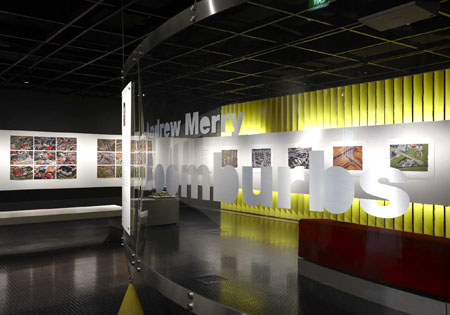
Historic Houses Trust
The exhibition text tells us that each photographer had arrived at a personal or professional crossroads when they found themselves unexpectedly inspired by Sydney's suburbs as a photographic subject. In 2005, Merry was in a helicopter returning from a failed reconnaissance over the Sydney Harbour Bridge and the Opera House to Bankstown airport when he was struck by the shapes and colours of the buildings and suburban blocks beneath him. With pilot Martin Bass, Merry would return to this Sydney in three 1.5-hour flights, hovering within 300 metres of the ground, and taking hundreds of pictures. Unlike Merry, Hawson was not a professional photographer when she began her 52 Suburbs project — she was a well-travelled former copywriter, TV producer and documentary maker who found herself back in her hometown — but (like many of us) with little knowledge of it beyond her own milieu. She decided to expand her knowledge by launching her next photographic project: shooting a new suburb every week. Hawson's project became all-consuming, demanding on average six days a week of her time, from her initial visit through to developing her images and then updating her blog. What the exhibitions share then is a central good idea, well-executed. They are each, in very different ways, eye-catching and thought-provoking.
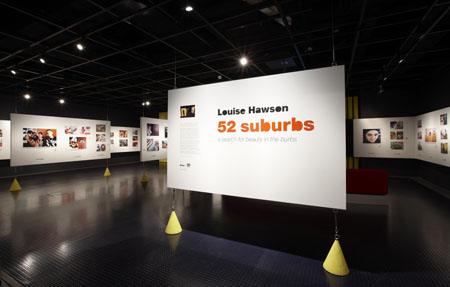
© Jenni Carter
Historic Houses Trust
To move the camera beyond the harbour, the postcard beaches and the gentrified inner city terraces also means the photographers inevitably engage with the intersecting histories of suburban growth and anti-suburban sentiment that characterise post-war Australia, and Sydney in particular. Hawson's very idea of seeking out beauty in the suburbs is an implicit counterpoint to Robin Boyd's scathing critique of suburban architecture and design in his 1960 book, The Australian Ugliness. Indeed, the 'featurism' of suburban Australian homes that Boyd lambasted has special allure for Hawson: tiled stairwells and rusting wrought-iron-barred windows frequently appear up-close and at flattering angles in her photographs. The red-brick homes and apartment blocks that were particularly offensive to Boyd are infused with a nostalgic glow by Hawson, who explains in a taped interview piped into the exhibition that she finds the 1970s version of this style 'ugly, beautiful'. She is also attentive to what people make of their homes well after they've built them. Quirky garden features, flags sprouting from windowpanes and religious icons dot her suburban images.
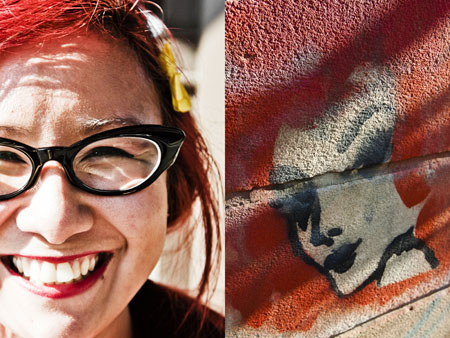
Merry's aerial vantage point suggests he was less interested in how residents turn their houses into homes than how suburbs come to be in the first place. By ranging across a number of new and even newer housing estates Merry captures their growth from early surveys of the landscape through to half populated streets onto densely populated suburbs where entire blocks are filled to capacity with enormous homes that just about squeeze into their allotted space. Swimming pools and trampolines take the place of backyards, and double-fronted garages tower over driveways. The Hills hoist that was visual shorthand for the Great Suburban Dream of a few decades earlier has no place; clothes are presumably laundered indoors by energy-sucking dryers. Suburban blocks are punctuated by roundabouts that appear gigantic even from the sky. Corner shops and local parks are conspicuous by their absence. More often than not, there are more cars than trees to be found on these mostly empty streets. Yet the exhibition also reveals that not all housing estates are the same. Amidst the uniformity, there are eccentric exceptions, including the odd single-storey home, the spacious backyard, and the mock Tudor house perched as if on an English country estate. There are also clear differences in planning and design: some estates are notable for the clash of competing styles; another stands out for the depressing prison grey of the exteriors.
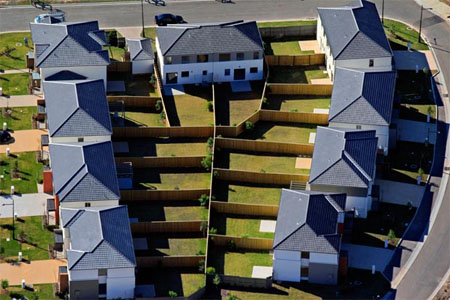
pigment print from the series Edgewood: Aerial Photography of New Suburbia
If Hawson's approach connects her to Robin Boyd, Merry's exhibition can be read as part of an ongoing debate initiated by social scientist Hugh Stretton in Ideas for Australian Cities. In 1970, as the post-war expansion of the housing market increasingly pushed cities such as Sydney outwards away from the centre, Stretton made a passionate plea to governments not to quarantine public planning from social and economic policy. Rather than ghettos, alienated suburbs and sharp divisions between the rich and the poor, Stretton argued for communities and championed a seventies version of what we would now call the work-life balance. Fast forward through 30 years and suburban divisions may remain as sharp if the enduring north-east-west-south axis is any index, but the popularity of McMansions, typically located in Sydney's outer west and peripheries, illustrates new demographic trends and presents a new suite of problems for planners and other interested parties to ponder. The video and wall text, for instance, foreground the environmental cost of building and maintaining huge homes as population growth continues. Highways that loom over outer suburbs, connecting them to the metropolis, also raise concerns about the potentially vast distances residents may travel daily to get to and from home and work. Yet Merry resists any overarching interpretation of the boomburbs. He is not out to challenge the Great Australian Dream of home ownership, though his impressively-sized and arresting images suggest that reality often falls short of the ideal.

pigment print from the series Edgewood: Aerial Photography of New Suburbia
Visitors to Hawson's exhibition learn that Sydney is a 'sprawling, multicultural city of 683 suburbs'. Showcasing just 52 of them must have presented a challenge. The otherwise effusive praise for the exhibition in the visitors' book was tempered only by complaints that certain suburbs were left out. Why Bonnyrigg, and not Yagoona? Why Wahroonga and not Berowra? Still Hawson is not an ethnographer; her coverage is wide and inclusive, but her approach is intuitive and inductive rather than systematic. The point is not socio-realism, and her often enchanting images are unabashedly manipulated to bring out the vivid best in her subjects, be they loved-up teenagers visiting Luna Park, native plants in sensuous bloom or fresh street art. It is difficult to pick favourites, but the format seems to encourage it. Of the portraits, my favourite is of the 'glamorous gypsy' Veruska Wolf pushing her trolley out of a supermarket in Penrith. Hawson also favours hanging two pictures next to one another or merging them into a revised or scaled down triptych. This approach lends itself to all sorts of interesting variations and juxtapositions, though my favourite, Motherly Love, was among the most simple. On one side, there's Mary Mother of God and Baby Jesus etched Picasso-style onto a stained-glass window at St Andrews Ukrainian Catholic Church in Lidcombe, on the other, a modern-day mother and son holding one another in the local pool.
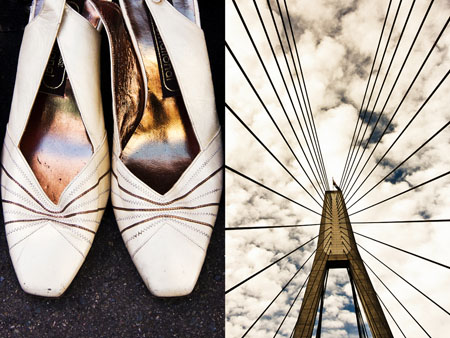
Perhaps because they were the least known to her, Hawson found Sydney's western suburbs — where she sometimes felt like the 'whitest white chick on the planet' — the most interesting places to visit. The images testify to her friendly curiosity, and if occasionally her celebrations of difference and diversity verge on an aesthetic representation of what anthropologist Ghassan Hage has called 'white multiculturalism' — the consumption of multiculturalism for white, middle-class tastes — the accumulated power of 52 Suburbs makes it difficult to sustain such a critique. If Merry is interested in why people build the houses that they do, or why the new housing estates for the aspirational classes may or may not be a good idea, Hawson's questions appear to be of a different order: Why do people live where they do? What rituals bring them together? What food do they like? What is the view like from the main street or the house on the corner? What does that glorious tattoo look like up close? Viewed consecutively the exhibitions encouraged me, and fellow visitors to the Museum of Sydney, to reflect on what it means to live in the city and to share our spaces. And, while 52 Suburbs offers encouraging evidence, post-Cronulla riots, of a thriving multicultural city, Boomburbs turns the lens elsewhere to question the social and environmental costs of a city that continues to grow.
Zora Simic is a historian of twentieth-century Australia, in the School of History and Philosophy, University of New South Wales, whose publications include articles on teenage mothers and identity politics in Sydney's western suburbs.
| Exhibition: | Boomburbs: Andrew Merry |
| Institution: | Historic Houses Trust |
| Curator: | Annie Campbell |
| Floor space: | 125 square metres |
| Venue/dates: | Museum of Sydney Theme Gallery, Bridge Street, Sydney, New South Wales, 16 October 2010 – 13 March 2011 |
| Exhibition: | 52 Suburbs: A Search for Beauty in the 'Burbs |
| Institution: | Historic Houses Trust |
| Curator: | Inara Walden |
| Floor space: | 125 square metres |
| Venue/dates: | Museum of Sydney Theme Gallery, Bridge Street, Sydney, New South Wales, 14 May – 9 October 2011 |
| Book: |
Louise Hawson, 52 Suburbs: A Search for Beauty in the Sydney 'Burbs, University of NSW Press, Sydney, 2011, ISBN 9781742232393, RRP A$39.95 http://www.52suburbs.com/2011/02/52-suburbs-book-cover-and-other-news.html |
